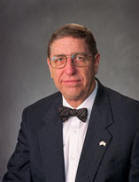There were tough choices for TV viewers tonight. The choices included Sunday Night Football (New England vs. San Diego), The Emmys and 60 Minutes with the Alan Greenspan interview.
I chose the Greenspan interview. If you are reading this blog you probably made the same choice.
Alan Greenspan is one of the fascinating characters of the second half of the 20th Century and he remains influential today. He is famously inscrutable which made this evening’s interview so fascinating. Particularly interesting was what 60 Minutes left on the cutting room floor about his formative years.
So here is the “rest of the story” as my parent’s Carefree, Arizona neighbor Paul Harvey used to say:
First, money for school was tight for Alan. It was mentioned in the interview that he toured with the popular Henry Jerome swing orchestra. It was not mentioned that he dropped out of Juilliard to join the band and earn some money for his education. He famously read books about economics in his room while his fellow band members boozed the nights away. The fact was he loved numbers. He devoured them in the form of baseball statistics, railroad schedules and while on tour his fellow band members noticed this and he ended up doing their taxes.
He earned enough to go to New York University for a BA and MA in Economics. He started on a PhD at Columbia University but he couldn’t afford the tuition and dropped out in 1951. 26 years later New York University conferred the PhD on him without requiring a dissertation – a good decision. I’ll bet some people at Columbia wished they thought of it first. I have a high school classmate that became the President of Columbia University who I know would have thought of it – but he wasn’t President in 1977.
With his education in place in 1951 he entered the world of work and started to have a social life. He fell in love and married a young Canadian art student from Winnipeg. Her name was Joan Mitchell (I do not believe she is related to his current wife Andrea Mitchell).
Joan came from a Winnipeg family that ran jewelry stores and her father was known to be tough and headstrong but allowed her to go to New York City for her education. My source for much of this information is Arthur Gillman, a famous “number man” in his own right whose knowledge about much of this is personal and whose family is from Winnipeg. Arthur’s family rented from the Mitchell’s and Arthur recalls in 1952 talking to Joan’s father about the new son-in-law and being told “He has promise.”
How Joan and Arthur’s grandparents ended up in Winnipeg is a fascinating story. It includes harrowing escapes from Russian persecution in those troubled times. The Jewish émigrés journeyed up the center of the North American Continent from Galveston, Texas following the Mississippi river system to cross the border into Canada all the while looking for places that would accept them. Land in Canada was free to those who would break the sod and put the land into production which is why Canada was the end of the journey. Émigrés dropped off along the journey to join Jewish enclaves in the cities along the way if they found opportunities.
In a future blog I will tell you how the journey eventually led to a key event that made the formation of Israel possible. Arthur has seen the stone memorial sent from the grateful nation of Israel to a synagogue in Kansas City that memorializes the event – but let’s get back to how this Canadian connection influenced Alan Greenspan and may have changed the course of American economic history.
Joan was not the only Winnipegger in New York City finding their way. Leonard Peikoff from Winnipeg was also a student at New York University and part of a group called “The Collective” that formed around the author Ayn Rand (Alissa Zinovievan Rosenbaum). Rand was also from a Russian Jewish family.
Peikoff and Joan knew each other. Joan introduced Alan to the group surrounding Rand and he became part of The Collective.
In the 60 Minutes interview Greenspan was asked about his nickname in the group “The Undertaker” and about Ayn Rand’s comment that he was a social climber. He seemed perplexed at the question.
Alan’s marriage to Joan only lasted from 1952 to 1953 but Rand became a friend and mentor to Alan who wrote for her “The Objectivist” newsletter.
Alan owes a lot to the Rand connection which gave him a platform to meet people of influence that would help him in his career. If he had not met and fallen in love with Joan and her friends had not introduced him to Rand he may have had a very different career and America might have had a different economic history for the last twenty years.
For those of you wondering, I switched to the game after the interview – New England won 38 to 14 but a fascinating ad kept popping up for the iPod Nano from Apple during the game. It featured an impossible to forget song called the “1234” Song and drove bloggers crazy trying to identify the “girl in the blue spangled costume.” It was Canadian singer/songwriter Leslie Feist and here are the complete lyrics – an appropriate love song for a blog about Alan Greenspan falling in love from yet another Canadian connection. He would appreciate a song whose title is all numbers!
One Two Three Four
Tell me that you love me more
Sleepless long nights
That is what my youth was for
Old teenage hopes are alive at your door
Left you with nothing but they want some more
Oh, you're changing your heart
Oh, You know who you are

